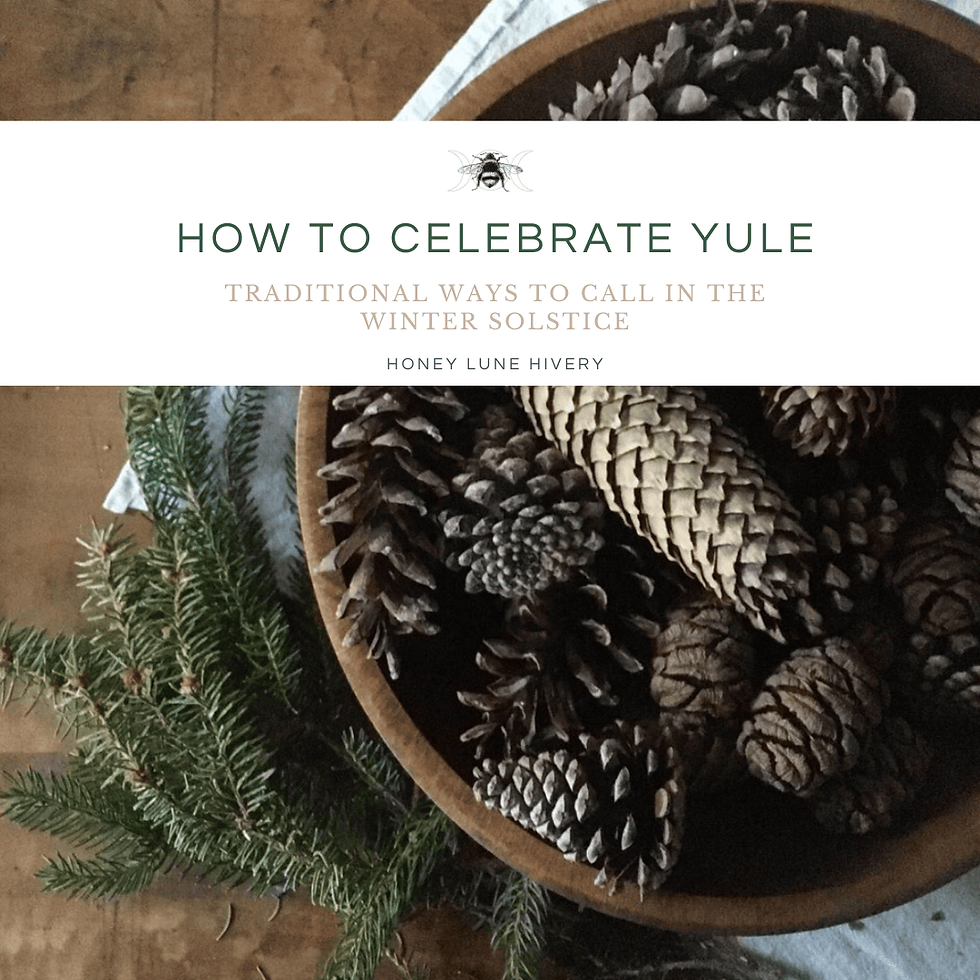Plants and Herbs Samhain - Traditional Herbs to Connect to Halloween
- honeylunehivery
- Oct 18, 2021
- 4 min read
Updated: Jun 12, 2022

Samhain is one of the main festivals in the pagan calendar. Taking place on October 31st, it marks the end of the year. At this time, the veil between our world and the spirit is at its thinnest, and we are able to communicate with souls more easily.
There are many traditions and practices for Samhain. Most common are traditions that honor the dead. It is a time of remembrance for our ancestors, and altars and shrines would be decorated for these former souls to visit. Samhain is also a time of divination. Since we have better access to the spirit world, many people would use this time to ask questions regarding their future.
Contact from spirits was not just with former loved ones. Negative entities roam the earth as well, and many people would protect themselves and their homes from these beings. One such group was the fae. Both positive and negatives stories of faeries have been told, but traditionally, the fae were mischievous creatures that would often cause tricks and misfortunes for humans that encountered them. Many Samhain traditions are derived for the protection from fairies.
Pagan holidays and their traditions incorporate items found in nature, such as fruit, trees, and herbs. Paganism has a deep EcoSpiritual connection, from celebrating the cycle of the seasons to working with the four elements. Items found in nature contain their own magick, and pagans utilize this in their own crafts.
Whatever your traditions are for Samhain, here are plants to bring to your magick practice this year…
Apple
Apples have a deep association with Samhain. In fact, this holiday was also called “Feast of the Apples”. It is a sacred fruit to the Celts and is a symbol of life and immortality. It was offered to the ancestors at Samhain, being buried at graves to give food to the souls waiting to be reborn. Another myth is that an apple branch bearing grown fruit, flowers, and unopened buds was a magickal key to the land of the Underworld.
Use: Honoring Ancestors and contacting the spirit world
Blackthorn
If apples are the fruit of Samhain, Blackthorn is the tree. Found primarily in the British Isles, it was widely used by pagans. It is known esoterically as both ‘Mother of the Woods‘ and the ‘Dark Crone of the Woods‘, symbolizing death and the last stages in the cycle of life. This connect to Samhain, as it is the end of the pagan year. Traditionally, it was used for purification as well as protection, ridding the atmosphere of negative spirits and energies.
Use: Protection from negative spirits
Hazel
Hazel is a tree of mysticism and magick. Sacred to fairies, wands made from hazel wood were thought to summon the fey. The mistletoe that grows on Hazel protects you from being bewitched and bound twigs were carried for protection.
Twigs, nuts and branches were gathered after sunset on Samhain when the magickal power of the tree is at its peak. These were used in spirit contact, dreams, divination, and dowsing. Sleeping under a hazel tree was thought to give you vivid dreams.
Use: Spirit contact, protection, and divination/enhance psychic powers
Mandrake
Anglo-Saxons believed Mandrake as a defined herb for demonic possessions. Known as ‘Root of the Witches’, it was used heavily in spells to protect one’s energy against evil spirits.
Use: As Mandrake is poisonous, do not ingest. Use roots on altar or carve into them for sympathetic magick for protection.
Marigold
Marigold is considered the ‘flower of the dead’in Mexico, and is still used to decorate altars for Dia de los Muertosas offerings to ancestors. Wreaths of marigold hung over a door are said to keep evil and negativity from entering.
Use: Honoring Ancestors, protection
Mugwort
A strong plant for magick, it was burned with wormwood to increase contact to the spirit world. Burned on Samhain, it aids in evocation, divination, scyring and prophecy. Holding association with the moon, it is an herb connecting to witches and mystical women of all kinds.
Use: Divination, enhance psychic abilities, contact with the spirit world
Patchouli
Also known as the ‘Graveyard dirt’because it’s earthly, wet soil like smell, Patchouli is known for its magical properties to raise Earth Energy and help us ground our magical powers. It was often used in ceremonies where spirits were involved.
Use: Contact with the spirit world
Rosemary
Rosemary has a long history of being associated with death. In England, it was burned in the homes of those who had died from illness, and placed on coffins before the graves were filled with dirt. It is an herb of remembrance, and often used in rituals to honor the memories of ancestors or loved ones lost.
Many cultures considered it a herb to use as protection from evil spirits and witches. Its purification properties have been used in spells to ward off evil. Rosemary is also believed to attract the fae and good energies and was hung over cribs to prevent infants from being snatched by the evil fairies.
Use: Use rosemary on an ancestor altar, protection from the fae
Rowan
This tree is still used in Scotland as way to protect from evil spirits. Using the branches and placing them over doors, it is a way to prevent negative energies from entering your home.
Use: Protection from negative spirits
If you are interested in learning more about Samhain and the autumn season, check out my Fall ebook for recipes, rituals, and ways to connect to the season.









Comments